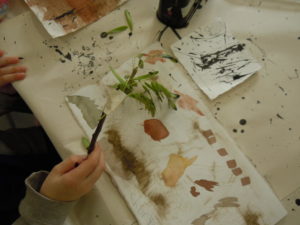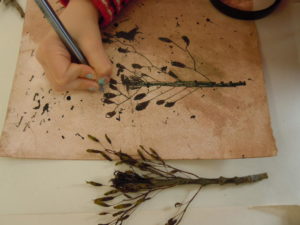Drawing and painting is like second-nature to most children, but what happens when you ask them to go beyond just putting pen to paper? A unique collaboration between the University of Melbourne and a Melbourne primary school produces a children’s art project inspired by the work of naturalist and artist John Wolseley. Landscape architect Annette Warner, also a horticulturalist and lecturer with the Faculty of Science, School of Ecosystem and Forest Sciences, and Hannah Rother-Gelder, artist and art co-ordinator, Princes Hill Primary School (PHPS) are inspired to bring a different way of approaching art, science and the environment to primary school children. This video shows the outcome of their 2015 collaboration, a collage of children’s art inspired by and created from the landscape around their school. In the accompanying text, Ms Warner describes the background of the project, the creative process and the artist who inspired it, John Wolseley.
It is this search for new ways of looking at the Australian natural environment which break with the European visual conventions that has characterised John Wolseley’s work over the past twenty years.’ Sascha Grishin in John Wolseley Land Marks III, 2015)\. Time, place and good old serendipity were instrumental in aligning what may have been innocuous chit-chat about a 2015 exhibition of work by John Wolseley at the Ian Potter Centre, National Gallery of Victoria. The conversation began with Hannah’s astute observations about how Wolseley’s work seemed to capture the elusive qualities of the Australian landscape. Of course, to a lecturer in landscape design, the words ‘elusive qualities’ and ‘Australian landscape’ were like steel to a magnet.

So I told Hannah about my experience on a drawing expedition with John Wolseley to Mount Buller about 15 years ago. On that trip, John gave each of us a ‘Yowie’, a foil-wrapped chocolate creature with a toy animal inside that was all the rage at the time. We were told to take on the persona of this animal and to ‘see’ the bush through the eyes of this creature. From this unique perspective, we drew upon and learnt John’s techniques of apprehending landscape. From this discussion, Hannah and I developed an art program that would engage students aged five to 12. Children created their own imaginary creature and through this avatar, came to understand methods and techniques common to both art and science, thereby creating a space where these shared a common ground. Each group of children was designated a site on the edge of the school and this became their creature’s habitat. John Wolseley sees nature as a collaborator in art and so we encouraged the children to collect materials from the site to make brushes, and infuse the environment into their paper by, for example, wrapping it around a tree or burying it in the ground.

Familiarisation with site is key to understanding it and the students worked on producing observational drawings based on botanical traditions using line work and colour. Students as young as five and six were able to record the landscape using these techniques and in our opinion produced some of the most beautiful and creative works. Both Hannah and myself agreed that it was important that the work of every student should be represented in the exhibition in some way. Collage was initially used to format the work, but quickly became inseparable to the process of curating it, transforming the landscape of the school into a palimpsest. The art produced by these students is a landscape of the imagination informed by the context and materials of the school ground. It is inspiring to think that a method developed by Wolseley has a life beyond the bush and can also influence how we perceive the landscape of the city.
This article was first published on Pursuit. Read the original article.






